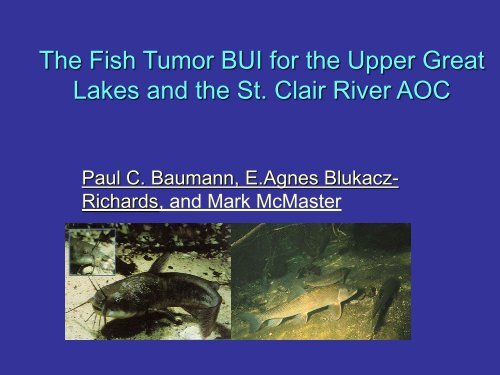3-Fish Tumours and Deformities - Friends of the St. Clair River
3-Fish Tumours and Deformities - Friends of the St. Clair River
3-Fish Tumours and Deformities - Friends of the St. Clair River
Create successful ePaper yourself
Turn your PDF publications into a flip-book with our unique Google optimized e-Paper software.
The <strong>Fish</strong> Tumor BUI for <strong>the</strong> Upper Great<br />
Lakes <strong>and</strong> <strong>the</strong> <strong>St</strong>. <strong>Clair</strong> <strong>River</strong> AOC<br />
Paul C. Baumann, E.Agnes Blukacz-<br />
Richards, <strong>and</strong> Mark McMaster
IJC Delisting Guidelines for<br />
BUI #4: <strong>Fish</strong> Tumors, 1991<br />
When <strong>the</strong> incidence rates <strong>of</strong> fish tumors<br />
or o<strong>the</strong>r deformities do not exceed rates<br />
at unimpacted control sites<br />
When survey data confirm <strong>the</strong> absence<br />
<strong>of</strong> neoplastic or preneoplastic liver<br />
tumors in bullheads or suckers
Biomarkers: Traits <strong>St</strong>rong to Weak<br />
• Causal Certainty<br />
• Liver neoplasms<br />
• Hepatic Altered Foci<br />
• Skin neoplasms<br />
• Barbel deformities<br />
• Sensitivity<br />
• Barbel deformities<br />
• Skin neoplasms<br />
• Hepatic Altered Foci<br />
• Liver neoplasms
Sentinel <strong>Fish</strong> Used for Tumor<br />
<strong>St</strong>udies<br />
• Brown Bullhead: Species used for most<br />
studies in <strong>the</strong> Lower Great Lakes<br />
• White sucker: Species used for most<br />
studies in <strong>the</strong> Upper Great Lakes<br />
• Shor<strong>the</strong>ad Redhorse: Species selected for <strong>St</strong>.<br />
<strong>Clair</strong> <strong>River</strong> survey<br />
• Walleye: Species studied in several<br />
systems (<strong>St</strong>. Lawence <strong>River</strong>)
Legend<br />
Binational RAPs<br />
Canada<br />
U.S.A.<br />
Areas in Recovery<br />
Delisted Canadian AOCs<br />
Delisted U.S. AOCs<br />
Impaired n = 10
Species <strong>and</strong> Lake Basin by Location<br />
• Thunder Bay<br />
• Jackfish Bay<br />
• <strong>St</strong>. <strong>Clair</strong> <strong>River</strong><br />
• Detroit <strong>River</strong><br />
• Wheatley Harbour<br />
• Niagara <strong>River</strong><br />
• Hamilton Harbour<br />
• Toronto<br />
• Bay <strong>of</strong> Quinte<br />
• Cornwall<br />
• Superior, Sucker<br />
• Superior, Sucker<br />
• Huron, Redhorse<br />
• Inter. R., Bullhead<br />
• Erie, Bullhead<br />
• Inter. R., Bullhead<br />
• Ontario, Bullhead<br />
• Ontario, Bullhead<br />
• Ontario, Bullhead<br />
• Inter. R. Bullhead
Walleye Epidermal <strong>Tumours</strong><br />
• Lymphocistis mimics skin neoplasms,<br />
caused by virus<br />
• Walleye dermal sarcoma<br />
– Retrovirus transmitted with cell-free filtrate<br />
(1990)<br />
• Discrete epidermal hyperplasia<br />
– Identified two related retroviruses, WEHV 1<br />
<strong>and</strong> WEHV2 (1991 & 1998)<br />
– Induced with cell-free filtrates (1998)
<strong>St</strong>. <strong>Clair</strong> <strong>River</strong> AOC – Sampling sites
Shor<strong>the</strong>ad Redhorse<br />
�Maxima: 75cm (length), 3.9 kg<br />
(weight), 9 years old<br />
� Widely distributed in Great Lakes –<br />
<strong>St</strong> Lawrence<br />
�Feeds on small benthic invertebrates<br />
�Selected at SCR as bullhead <strong>and</strong><br />
white suckers were not common
Upper Lakes Liver Tumor Prevalence<br />
at AOCs <strong>and</strong> Reference Sites (R)<br />
Location # <strong>of</strong><br />
<strong>Fish</strong><br />
Neo. %<br />
1986-90<br />
Neo. %<br />
2003-07<br />
Signif.<br />
Differ.<br />
Thunder 100 7.1% 2% No?<br />
Mt. Bay - R 100 2.4% 0%<br />
Jackfish 100 7.2% 0% No<br />
Mt. Bay - R 100 2.4% 0%<br />
<strong>St</strong>. <strong>Clair</strong> 126 NA 0% No<br />
L. Huron - R 100 NA 1%
<strong>St</strong> <strong>Clair</strong> <strong>River</strong> AOC Conclusions<br />
�No historical data on bullhead or sucker liver tumours<br />
exists for <strong>the</strong> <strong>St</strong>. <strong>Clair</strong> <strong>River</strong>.<br />
�No liver tumors were observed in <strong>the</strong> survey <strong>of</strong> shor<strong>the</strong>ad<br />
redhorse from <strong>the</strong> <strong>St</strong>. <strong>Clair</strong> <strong>River</strong>.<br />
�Shor<strong>the</strong>ad redhorse from Lake Huron had a 1% prevalence<br />
<strong>of</strong> liver tumors, as did brown bullhead from reference sites<br />
�Male to female ratio was similar at AOC <strong>and</strong> reference site.<br />
�Sample population was older than reference site
One More Survey ?<br />
• First Nations use <strong>St</strong>. <strong>Clair</strong> walleye as<br />
major food source<br />
• Walleye are a predominant game species<br />
• Walleye are known to develop liver<br />
tumours.<br />
• Age related walleye tumour rates have<br />
been published<br />
• Such a sample effort is feasible
Acknowledgements<br />
Bob Evans (Department <strong>of</strong> <strong>Fish</strong>eries <strong>and</strong> Oceans)<br />
Scott Brown (Environment Canada)<br />
Cam Portt<br />
Great Lakes Ecosystem Initiative<br />
Great Lakes Action Plan<br />
Environment Canada<br />
Ministry <strong>of</strong> Natural Resources<br />
Department <strong>of</strong> <strong>Fish</strong>eries <strong>and</strong> Oceans<br />
Technical Operations, NWRI<br />
Field <strong>and</strong> Laboratory Teams<br />
Environment Canada (Ontario Region) for funding P. Bauman


